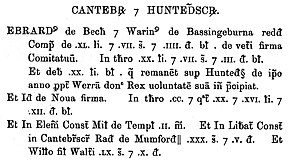Record type



Record typeis a family oftypefacesdesigned to allowmedievalmanuscripts (specifically those from England) to be published as near-facsimilesof the originals. The typefaces include many special characters intended to replicate the variousscribal abbreviationsand other unusualglyphstypically found in such manuscripts. They were used in the publication ofarchival textsbetween 1774 and 1900.
History
[edit]Record type was originally developed in the 1770s when plans were under way for thepublication of Domesday Book.Early experiments in using special typefaces were not successful, but in 1773 the printerJohn Nicholsdesigned a record type for an extract from Domesday to be included inJohn Hutchins'History and Antiquities of the County of Dorset(published in 1774). He was so pleased with the result that he and the co-editor of Domesday,Abraham Farley,persuaded theTreasurythat the typeface should be adopted for the main Domesday project. It was consequently used inFarley's edition of Domesday Book,published in 1783. Nichols regarded the design as among his greatest achievements, stating that "on the correctness and beauty of this important Work, I am prepared to stake my typographical credit".[1]
The original Domesday type was destroyed in the fire at Nichols' office in 1808,[2]but a modified form of record type was widely used during the first half of the 19th century in the publications of theRecord Commission.It was subsequently used in the publications of thePipe Roll Societyfrom 1884 until 1900; and in 1890 in a single volume published by theSelden Society(despite the misgivings of the society's founder,F. W. Maitland).[3][4]The Selden Society's experiment was not repeated, and at a General Meeting held in 1903 the Pipe Roll Society decided to abandon record type in favour of publishing its texts "in extenso"(i.e. with all abbreviations extended).[5]
Legacy
[edit]Record type fell out of favour because its merits (primarily the fact that, given accurate transcription, the reader was presented with a faithful representation of what appeared on the manuscript page) were increasingly felt to be outweighed by its disadvantages: the high costs of typesetting and proofreading, and the challenges to the reader presented by a text prepared with minimal editorial intervention.[6]Moreover, technical advances by the late 19th century meant that, in cases where there was a genuine argument for facsimile publication, this could be achieved more satisfactorily, cheaply and accurately by means ofphotozincographyand other photographic printing techniques.
Paul Harvey regards record type as falling "badly between two stools, giving less than a facsimile on the one hand, less than an extended text on the other".[7]Nevertheless, L. C. Hector has argued that the modest amount of rationalisation and standardisation required to set a manuscript in record type resulted in a "half-way stage towards the interpretation of the abbreviations" that remains a useful tool to assist the novice in medievalpalaeography.[8]
Charles Trice Martin'sThe Record Interpreter(first edition 1892; second edition 1910), which remains a standard handbook for the interpretation of English medieval manuscript texts, employs a version of record type to present abbreviated words.[9]
A more recent example of a text printed in record type format – in practice, improvised from a variety of existing typographical characters – is an edition of the late 14th-century "Jubilee Book" of theCity of London,from a 15th-century manuscript, published by theLondon Record Societyin 2021. The choice is justified by the complexities of the linguistic evidence presented by the source text.[10][11]
A continuing desire in the digital age to represent the special characters of medieval texts in typographical form is also demonstrated by the establishment in 2001 of theMedieval Unicode Font Initiative,which aims to coordinate the encoding and display of such characters.
References
[edit]- ^Condon and Hallam 1984, pp. 377–9.
- ^Condon and Hallam 1984, p. 379n.
- ^Baildon, William Paley, ed. (1890).Select Civil Pleas: Volume 1, A.D. 1200–1203.Selden Society. Vol. 3. London: Selden Society.
- ^Yale, D. E. C.;Baker, J. H.(1987).A Centenary Guide to the Publications of the Selden Society.London: Selden Society. pp. 22, 34.
- ^The Great Roll of the Pipe for the Twenty-Second Year of the Reign of King Henry the Second: A.D. 1175–1176.Pipe Roll Society. Vol. 25. London. 1904. pp. vii–viii.
{{cite book}}:CS1 maint: location missing publisher (link) - ^Hunnisett 1977, p. 24.
- ^Harvey 2001, p. 47.
- ^Hector 1966, p. 36.
- ^Martin, Charles Trice (1910).The Record Interpreter: a collection of abbreviations, Latin words and names used in English historical manuscripts and records(2nd ed.). London: Stevens and Sons.
- ^Barron, Caroline M.; Wright, Laura, eds. (2021).The London Jubilee Book, 1376–1387: an edition of Trinity College Cambridge MS O.3.11, folios 133–157.London Record Society. Vol. 55. Woodbridge: Boydell Press. p. 46.ISBN9780900952616.
Abbreviation and suspension symbols are reproduced as far as is possible in modern type.
- ^Freeth, Stephen (2021). "The London Jubilee Book, 1376–1387: an edition of Trinity College Cambridge MS O.3.11, folios 133–157 [review]".Transactions of the London and Middlesex Archaeological Society.72:354–356.
The transcript is rendered in 'Record Type', such as was used in the 19th century by the Record Commissioners, complete with abbreviation and suspension symbols. This has been created with great ingenuity using commonly available software, such as a superscript numeral 9 to indicate a loopingascender.
Sources
[edit]- Condon, M. M.; Hallam, E. (1984). "Government Printing of the Public Records in the Eighteenth Century".Journal of the Society of Archivists.7(6): 348–88.doi:10.1080/00379818409514252.
- Harvey, P. D. A. (2001).Editing Historical Records.London: British Library. pp. 47–50.ISBN0-7123-4684-8.
- Hector, L. C. (1966).The Handwriting of English Documents(2nd ed.). London: Edward Arnold. pp. 35–6.
- Hunnisett, R. F. (1977).Editing Records for Publication.Archives and the User. Vol. 4. London: British Records Association. p. 24.ISBN0-900222-05-0.
